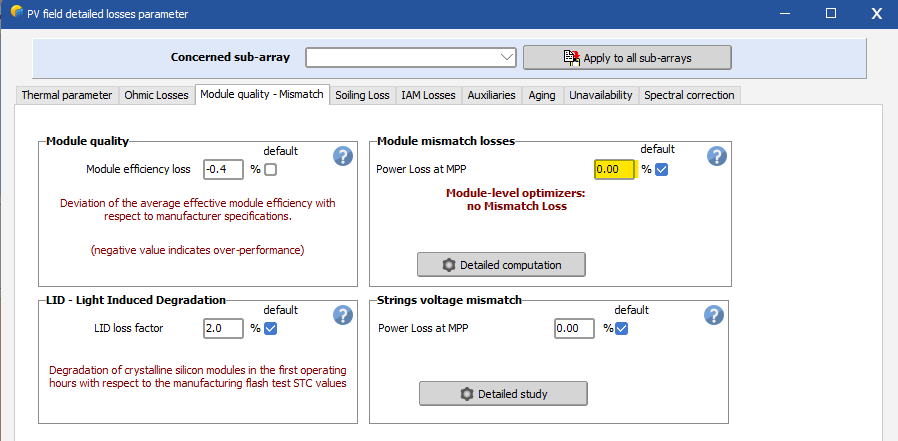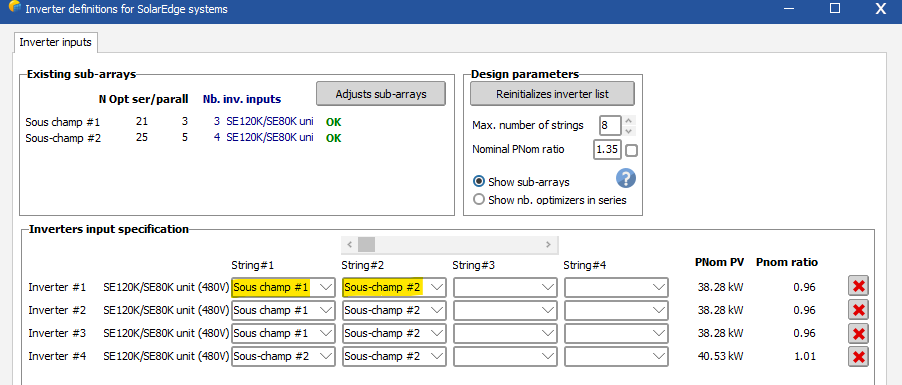-
Posts
54 -
Joined
-
Last visited
Everything posted by Robin Vincent
-
Update: In the V7, most of the time the number of sheds used for the sky diffuse on the rear side was set to 3. It meant that 2/3 of the sheds were impacted by mutual shadings, regardless of your project. Starting with the v8.0.0, we now use data from the system for this computation, which in most case results in a reduction of the diffuse energy on the rear side (a greater percentage of the sheds are shaded). This value is likely to change again a little in the V8.0.6, as we fixed a minor issue.
-
As mentioned in the other thread, the only way to mix orientations within a string is to use the averaged orientation option. This also means the transposed irradiance will be the same for all your modules sharing this orientation, so it won't generate any mismatch. Other effects (notably shading) will use the real orientation. But in your case, it should not change anything : string mismatch should not occur with module level optimizers. You can still change that behavior in the detailed losses menu, Power Loss at MPP.
-
Hi, Please check this tread, as it could contain the answer to your question.
-
If I understand correctly, you need to mix different orientations in a same string. In that case, the only solution I can think off is to use the "average orientation" option, combining NE + E and SW + W. Based on your layout, the azimuts seem relatively close, so the resulting transposition error should be small. You may find more details here : https://www.pvsyst.com/help/project-design/orientations-in-v8/average-orientation.html?h=average This will allow you to define only two subarrays, each with strings long enough to be connected to a MPPT input. If you still have issues regarding your project, please contact us at support@pvsyst.com with your project attached.
-
You are correct, it is not possible to define a single subarray with mixed orientation and SolarEdge optimizers in PVsyst. Nevertheless, you can achieve a similar result by creating two separate sub-arrays, one for each orientation, then attribute the strings to the same inverter. To do so, open the "strings configuration" menu in the system definition, then set different sub-arrays to each input of your inverters
-
Actually, it is even trickier than that. For both values, changes are detected if any of the 1st 4 characters is changed. It usually means 1 digit for module quality (the "-" counts as a character) and 2 digits for the LID. Then, if the value is less than 0.1 point different from the default, it is set to the default value. The final value is then stored and, as you mentioned, only 1 digit is displayed. This is obviously not ideal, and we should harmonize the behaviors and make sur the number of digit displayed matches the number used. Nevertheless, such an accuracy (1/10000) is definitively not necessary in the 1st place.
-
This issue is due to a bug in the automatic string attribution to each MPPT (triggered when changing something in your system or when clicking on reinitialize inverter list). It should be solved in the 8.0.5. Meanwhile, to be able to simulate your system you can try deleting and adding back each inverter one by one until the error message disappear. Make sure your system is fully defined before doing so, as any modification on the subarrays definition will trigger a new string attribution,which could lead to the issue reappearance.
- 1 reply
-
- 3d shadings
- inverter
-
(and 2 more)
Tagged with:
-

Odd Numbered Strings in SolarEdge Architecture
Robin Vincent replied to jack.keane's topic in How-to
Yes this is planned for a future version of PVsyst (at least with optimizers), but I cannot give you any timeline for it. -

Odd Numbered Strings in SolarEdge Architecture
Robin Vincent replied to jack.keane's topic in How-to
No you cannot set heterogenous strings in PVsyst. The closest workaround would be to have subarrays with strings containing +1 and-1 modules relative to your odd-strings definition, and connect them to the same inverter. It won't be exactly equivalent, and only work if the total number of modules connected to the inverter is even. But at least the total DC power would be correct, and the impact on the different component efficiencies and threshold limited. -
Sub-hourly simulation is a simulation with a time step lower than 1 hour. It may be useful to correctly account for non linear phenomenon such as clipping and curtailment. It is currently not directly available in PVsyst, even though workaround exist to run pseudo sub-hourly simulation https://www.pvsyst.com/wp-content/pdf-tutorials/pvsyst-tutorial-v8-pseudo-sub-hourly-simulation-en.pdf or to have a better clipping correction estimation https://www.pvsyst.com/help/physical-models-used/grid-inverter/subhourly-clipping-correction.html?h=clipping. In both case, sub-hourly weather data is necessary.
-

Huawei optimizer strings configuration - ERRORS and CRASH
Robin Vincent replied to R. Polášek's topic in Problems / Bugs
Please contact the support by email at support@pvsyst.com with your project (project => export project) so we can have a better understanding of what is happening. -
The results export is restricted to the same time step as the simulation, which is set to 1 hour. Smaller time steps will be available once the sub-hourly simulation is.
-
No, the simulation itself is still hourly-based. We only extract additional info from sub-hourly weather data to correct the clipping losses.
-

Near shading loss without 3D shading scene
Robin Vincent replied to ClaireWest's topic in Shadings and tracking
With unlimited sheds, pretty much all the parameters you mentioned will impact the near shadings losses. You may be able to find more detailed information in the help page for diffuse losses with tracking systems : https://www.pvsyst.com/help/project-design/shadings/calculation-and-model/diffuse-losses-with-tracking-systems.html#tracker-diffuse-shading-definition-window-from-version-730 -

Near shading loss without 3D shading scene
Robin Vincent replied to ClaireWest's topic in Shadings and tracking
The backtracking strategy avoids direct mutual shadings, but not the other irradiance components. If you extract the simulation results with all the near shadings variables, you should be able to see that the Beam loss due to near shadings (ShdBLss) are equal to 0, but not the diffuse (ShdDLss) and albedo (ShdALss) components. -
Yes, all you need is a text file containing all the commands you want to pass through. Each command must be on its own line. For instance, to convert a weather data file, you can set up a text file (TestCLiCmd.txt) containing the following lines : -icf:path/file.csv -imf:path/file.MEF -isf:path/file.SIT -omf:path/file.MET And then simply run the command : PVsystCLI convert-meteo -cof:TestCLiCmd.txt from the same directory.
-
PVsyst integrates a set of rules, as requested by Huawei, to authorize or not some inverters / optimizers combination. A side effect is that if you create your own inverter it will not be compatible with any Huawei optimizers. You'll be able to use Sun5000 inverters with MERC optimizers in PVsyst8, which should be released in a matter of days or weeks.
-

Huawei optimizer strings configuration - ERRORS and CRASH
Robin Vincent replied to R. Polášek's topic in Problems / Bugs
Dear R. Polášek, Thank you for bringing up this issue. We are aware that the multi-string attribution on a single MPPT with Huawei inverters/optimizers currently has some limitations. If you're working with just one subarray, this shouldn't pose any problems. However, given your situation with multiple subarrays, unfortunately, it will not function as expected. We are actively working on a fix, which will be implemented in PVsyst V8. Until then, you won't be able to simulate your project as it is currently configured. As a temporary solution, we recommend ensuring that each inverter is connected to only one subarray. This should allow you to proceed with your simulation in the meantime. -
There is no real justification for limiting the number of periods to 5. It will be changed in a future PVsyst release.
-
We cannot help you in the definition of the periods themselves, as they are only related to your project. This information must be provided by your client or be part of your simulation assumptions.
-
@sarah95 When setting the unavailability factor to default, PVsyst will split the total duration onto 3 separate periods of equal length. These periods are randomly selected when you enable the unavailability factor for your different variants the 1st time. Thus, two variants using the default (random) unavailability period may end-up with very different unavailability losses. If you consider the unavailability of both systems should be the same, you can specify the same date, time and unavailability duration manually. @Auxi Madero In your variant, detailed losses ==> unavailability you can set a unavailability probability to 5%. With the rest of the settings unchanged, it will generate three random unavailability periods for a total duration of 5% of the whole year. You can find more information in the help page dedicated to the topic : https://www.pvsyst.com/help/index.html?unavailability_loss.htm
-

Higher system loss (Inverter, ..) in two months
Robin Vincent replied to Krishantha Wimalasiri's topic in Simulations
Dear Krishantha, To properly answer your question, you need to contact support@pvsyst.com and share your project with us. -
Dear sarah95, The unavailability figure defined in PVsyst represents the time fraction during which the system won't be able to produce electricity. The unavailability losses are not directly linked to the unavailability fraction, but also to when the system is not available (day, night, summer, winter, ...). Thus a same unavailability duration can give dissimilar unavailability related losses. You can find more details on our help page related to the subject : https://www.pvsyst.com/help/index.html?unavailability_loss.htm



